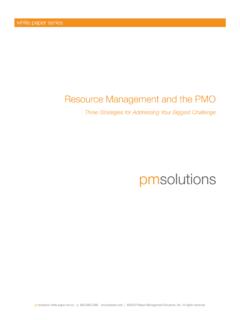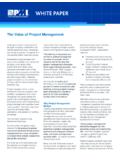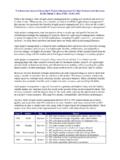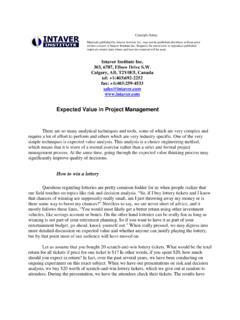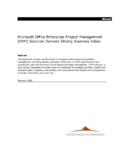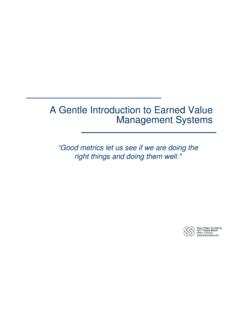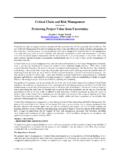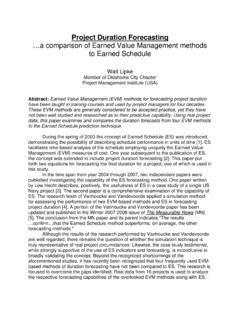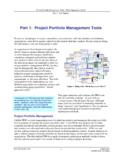Transcription of Measures of Project Management Performance …
1 Comprehensive List of Measures Page 1 of 34 Measures of Project Management Performance and value A BENCHMARK OF CURRENT BUSINESS PRACTICES Comprehensive List of Measures Page 2 of 34 Comprehensive List of Measures of PM Performance & value Implementing a pmValue Measurement System to measure Project Management Performance and value will help organizations achieve one or more of the following goals: to identify the business impact of implementing Project Management improvement initiatives to compare costs to benefits of Project Management improvement initiatives to determine if a Project Management improvement initiative is accomplishing its objectives to assist in marketing future Project Management improvement initiatives.
2 Note that these goals are based on determining the value of implementing Project Management improvement initiatives in the organization. That value is determined by showing improvement in some measure or Measures over time. Choosing those Measures is key to the success of the pmValue Measurement System. PM Solutions Center for Business Practices has compiled an extensive list of possible Measures for consideration. These Measures are a starting point for a pmValue Scorecard development process, not a simple menu to craft a pmValue Scorecard from. So use the list as a starting point to think about Measures that are most important to your organization s goals. We recommend that you select 3-7 Measures for your measurement system (it s too difficult and costly to collect too many Measures ).
3 Also note that you will be selecting Measures of Project Management value rather than Measures of Project Performance . The key difference in Performance Measures versus value Measures is the reason for doing the measuring. In measuring Performance , you are trying to gather information to help you make Management decisions to affect change that, hopefully, will improve that Performance . For example, Project Performance Measures are undertaken to provide information to managers in order to exert control over the Project . Those Measures must be appropriate to the organizational level that can immediately effect change based on information it learns in order to control the Performance of the Project at hand (measuring the earned value of the Project will provide information on the Performance of the Project to allow managers to make critical decisions to bring the Project to closure successfully).
4 These Measures must be collected fairly often, perhaps even weekly, depending on the duration of the Project . In measuring value , you are trying to demonstrate that decisions you made to implement change ( Project Management improvement initiatives) has indeed added value to the organization. So you are measuring value rather than Performance (which may or may not be the same). Sometimes (usually) improved Performance can be translated into value . For example, improving schedule Performance for all your projects over a period of a year can be translated into improvement in average Project cycle time, which can be translated into improvement in time to market, which can add significant value to your organization. value Measures , therefore, provide information on the Performance of the organization rather than the Performance of a Project .
5 They must be collected over a longer period of time (no more than quarterly) and over your portfolio of projects. Comprehensive List of Measures Page 3 of 34 TOP 10 Project Management BENCHMARKING Measures James S. Pennypacker Director-Center for Business Practices, PM Solutions There is no single set of Measures that universally applies to all companies. The appropriate set of Measures depends on the organization s strategy, technology, and the particular industry and environment in which they compete. That said, below are my choices for the top 10 Measures an organization should benchmark to lead to Project Management success. The Measures should be indexed that is, averaged over a large number of similar types of projects over a period of time (for example, per year).
6 Return on Investment (Net Benefits/Costs) x 100 The most appropriate formula for evaluating Project investment (and Project Management investment) is Net Benefits divided by Cost. By multiplying this result by 100, this calculation determines the percentage return for every dollar you ve invested. The key to this metric is in placing a dollar value on each unit of data that can be collected and used to measure Net Benefits. Sources of benefits can come from a variety of Measures , including contribution to profit, savings of costs, increase in quantity of output converted to a dollar value , quality improvements translated into any of the first three Measures . Costs might include the costs to design and develop and/or maintain the Project or Project Management improvement initiative, cost of resources, cost of travel and expenses, cost to train, overhead costs, etc.
7 Productivity Productivity is output produced per unit of input. Productivity Measures tell you whether you re getting your money s worth from your people and other inputs to the organization. Typically the resources have to do with people, but not always. A straightforward way to normalize productivity measurement across organizations is to use revenue per employee as the key metric. Dividing revenue per employee by the average fully burdened salary per employee yields a ratio. This ratio is the average-per-employee Productivity Ratio for the organization as a whole. Other productivity metrics might be number of projects completed per employee, number of lines of code produced per employee. The key to selecting the right productivity Measures is to ask whether the output being measured (the top half of the productivity ratio) is of value to your organization s customers.
8 Cost of Quality Cost of Quality/Actual Cost Cost of quality is the amount of money a business loses because its product or service was not done right in the first place. It includes total labor, materials, and overhead costs attributed to imperfections in the processes that deliver products or services that don t meet specifications or expectations. These costs would include inspection, rework, duplicate work, scrapping rejects, replacements and refunds, complaints, loss of customers, and damage to reputation. Cost Performance Earned value /Actual Cost The Cost Performance Index is a measure of cost efficiency. It s determined by dividing the value of the work actually performed (the earned value ) by the actual costs that it took to accomplish the earned value .
9 The ability to accurately forecast cost Performance allows organizations to confidently allocate capital, reducing financial risk, possibly reducing the cost of capital. CPI Standard Deviation is an even better metric, one that shows the accuracy of budget estimating. Schedule Performance Earned value /Planned value Comprehensive List of Measures Page 4 of 34 The Schedule Performance Index is the ratio of total original authorized duration versus total final Project duration. The ability to accurately forecast schedule helps meet time-to-market windows. SPI Standard Deviation is an even better metric that shows the accuracy of schedule estimating. Customer Satisfaction Scale of 1-100 Customer satisfaction means that customer expectations are met.
10 This requires a combination of conformance to requirements (the Project must produce what it said it would produce) and fitness for use (the product or service produced must satisfy real needs). The Customer Satisfaction Index is an index comprising hard Measures of customer buying/use behavior and soft Measures of customer opinions or feelings. Index is weighted based on how important each value is in determining customer overall customer satisfaction and buying/use behavior. Includes Measures such as repeat and lost customers (30%), revenue from existing customers (15%), market share (15%), customer satisfaction survey results (20%), complaints/returns (10%), and Project -specific surveys (10%). Cycle Time There are two types of cycle time Project cycle and process cycle.






